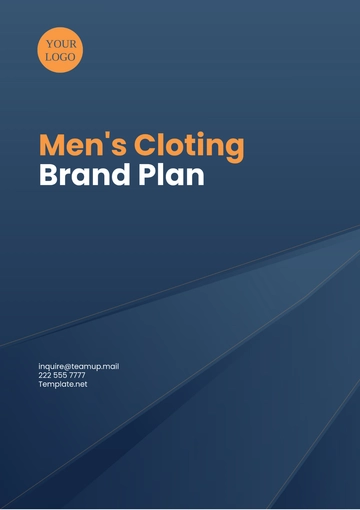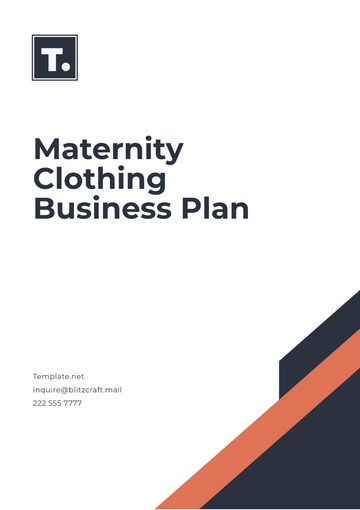Free Fashion Business Strategy Plan

I. Executive Summary
The Fashion Business Strategy Plan outlines our vision, objectives, and strategies for launching and managing a new fashion brand, [Your Company Name]. This document provides a comprehensive market analysis, competitive landscape, target audience, marketing strategies, financial projections, and operational plans to ensure that all business aspects are aligned with our goals. We aim to integrate technology with sustainable practices to cater to the modern consumer in an evolving fashion landscape.
II. Business Description
Our fashion brand, [Your Company Name], aims to revolutionize contemporary women's wear by combining unique designs with high-quality, sustainable materials. We target modern women who value both style and comfort. Our mission is to create clothing that empowers women, making them feel confident and fashionable in any setting.
A. Vision
To become a leading fashion brand known for innovative designs, unparalleled quality, and commitment to sustainability, setting trends in the fashion industry for generations to come.
B. Objectives
Launch the brand within 12 months.
Achieve a revenue target of $1 million in the first year.
Expand the product line by introducing a sustainable athleisure collection within 2 years.
Achieve a customer satisfaction rate of over 90% within the first year.
C. Services and Products
Our product line includes:
Dresses: Casual, formal, and event-specific designs.
Tops: A variety of blouses and t-shirts for every occasion.
Skirts: From casual to formal styles.
Accessories: Eco-friendly handbags, jewelry, and scarves.
III. Market Analysis
Our market analysis focuses on understanding the current fashion industry, identifying target customers, and analyzing competitors.
A. Industry Overview
The global fashion industry is valued at $3 trillion, with a steady annual growth rate of 6% projected through 2050. The women’s apparel segment represents the largest share, driven by increasing demand for versatile and sustainable fashion options.
B. Target Audience
Our target audience consists of women aged 25-45 who are fashion-conscious, tech-savvy, and environmentally aware. They typically have a disposable income ranging from $50,000 to $120,000 annually and are looking for brands that align with their values.
C. Competitive Landscape
We will compete with mid to high-end fashion brands such as Zara, H&M, Reformation, and emerging sustainable brands. Key differentiators for Elysian Threads include our unique designs, commitment to sustainability, and use of innovative fabric technologies like smart textiles.
D. Market Needs
The market demands fashionable yet comfortable clothing with a strong emphasis on sustainable practices. Our brand is poised to meet these needs by offering stylish designs made from eco-friendly materials and incorporating technology for enhanced functionality.
IV. Marketing Strategy
Our marketing strategy will focus on brand awareness, customer acquisition, and retention.
A. Branding
We will create a strong brand identity with a contemporary logo, a color scheme reflecting our eco-conscious ethos, and messaging that resonates with our target audience's values of empowerment and sustainability.
B. Digital Marketing
Effective digital marketing efforts will include:
Search Engine Optimization (SEO): Optimize our website for search engines to improve visibility.
Social Media Marketing: Engage audiences on platforms like Instagram, TikTok, and Pinterest through visually appealing content and storytelling.
Influencer Collaborations: Partner with eco-conscious influencers and fashion bloggers to reach a wider audience.
Email Campaigns: Personalized newsletters offering exclusive content, product launches, and promotions.
C. Offline Marketing
Participation in fashion shows, pop-up shops in urban areas, and exclusive events to increase brand visibility. Collaborating with local artists and designers will enhance community engagement and brand loyalty.
V. Operational Plan
The operational plan covers the day-to-day activities, production processes, and supply chain management.
A. Production Plan
We will partner with reputable manufacturers specializing in sustainable practices to ensure high product quality and timely delivery. Our production facilities will adhere to ethical labor standards and use renewable energy sources.
B. Supply Chain Management
A robust supply chain will be established to handle inventory procurement, warehousing, and logistics efficiently. We will leverage technology for inventory tracking and management to reduce waste and optimize stock levels.
C. Sales Channels
Our sales channels will include:
E-commerce Platform: An intuitive and user-friendly website optimized for mobile and desktop users.
Select Boutique Partnerships: Collaborating with high-end boutiques to reach customers who prefer in-person shopping experiences.
Virtual Showroom: Utilizing augmented reality (AR) technology to allow customers to try on clothes virtually.
VI. Financial Projections
The financial projections provide a forecast of our revenue, expenses, and profitability over the next five years.
A. Revenue Projections
Year | Revenue ($) |
|---|---|
Year 1 | 1,000,000 |
Year 2 | 1,500,000 |
Year 3 | 2,000,000 |
Year 4 | 2,500,000 |
Year 5 | 3,000,000 |
B. Expense Projections
Production Costs: Estimated at 40% of revenue.
Marketing Costs: Projected at 20% of revenue to ensure robust brand presence.
Operational Expenses: Fixed and variable costs associated with running the business, including salaries, utilities, and logistics.
C. Profitability
We expect to break even within the first year and achieve a net profit margin of 10% by the third year, increasing to 15% by the fifth year as the brand gains recognition and operational efficiencies improve.
VII. Management Team
Our management team consists of experienced professionals in fashion design, marketing, and business operations.
A. Founders
[Your Name]: Founder and Chief Executive Officer with over 10 years of experience in the fashion industry and a passion for sustainable practices.
Alanis Durgan: Co-Founder and Chief Creative Officer, a graduate of a prestigious fashion design school with a proven track record of innovative design.
B. Key Team Members
Chief Designer: Responsible for the creative vision and design of the product line.
Marketing Head: Manages all marketing initiatives and brand positioning strategies.
Operations Manager: Oversees production, supply chain management, and quality control.
VIII. Appendices
The appendices section includes supplementary materials such as:
Detailed financial statements.
Market research reports indicating consumer trends and preferences.
Legal documents including business registration and trademarks.
- 100% Customizable, free editor
- Access 1 Million+ Templates, photo’s & graphics
- Download or share as a template
- Click and replace photos, graphics, text, backgrounds
- Resize, crop, AI write & more
- Access advanced editor
Plan your fashion business with ease using this Fashion Business Strategy Plan Template from Template.net. It's fully editable and customizable, allowing you to tailor it to your specific goals and strategies. You can easily create a professional plan that's ready for success, editable in our Ai Editor Tool for quick updates and revisions.
You may also like
- One Page Business Plan
- Coffee Shop Business Plan
- Restaurant Business Plan
- Food Business Plan
- Real Estate Business Plan
- Executive Summary Business Plan
- Cover Page Business Plan
- Nonprofit Business Plan
- Daycare Business Plan
- Construction Business Plan
- Startup Business Plan
- Medical Business Plan
- Bakery Business Plan
- Service Plan
- Hotel Business Plan
- Catering Business Plan
- School Business Plan
- Healthcare Business Plan
- Transportation Plan
- Sports Plan
- Car Wash Business Plan
- Salon Business Plan
- Clothing Business Plan
- Farming Business Plan
- Boutique Plan





























